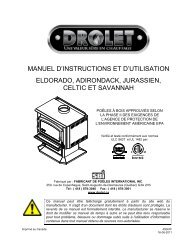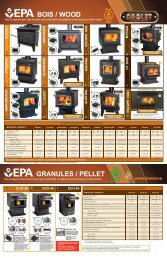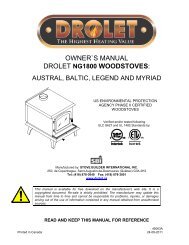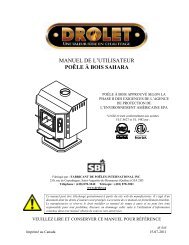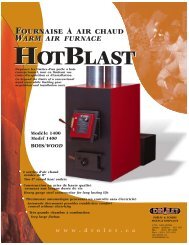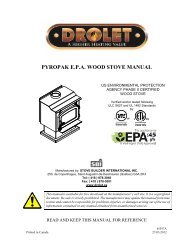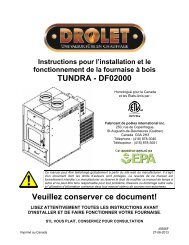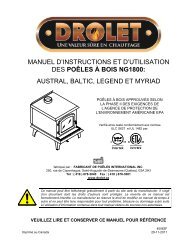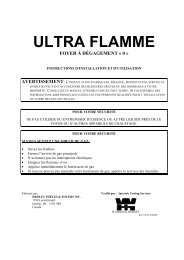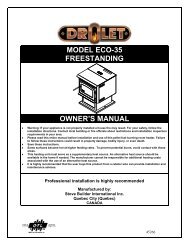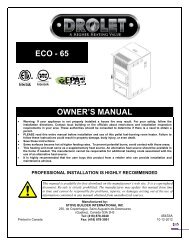Create successful ePaper yourself
Turn your PDF publications into a flip-book with our unique Google optimized e-Paper software.
Columbia Installation and Operation Manual8.5.1 Combustion Air Supply in Mobile HomesOnly a wood stove certified and labelled as ‘mobile home approved’ may beinstalled in a mobile home. The Columbia stove is ‘mobile home approved’. Wood stovesinstalled in mobile homes must have a ducted supply of combustion air from outdoors. Thisair supply should be routed down through <strong>the</strong> house floor into <strong>the</strong> vented crawl spaceunder <strong>the</strong> mobile home. The air supply duct should be non-combustible aluminum flex ductwith a screened wea<strong>the</strong>rhood on <strong>the</strong> outside end.Note: Fabric duct may also be used, provided it is suitable for HVAC use and meets <strong>the</strong>requirements of ULC-S110 or UL-181 Class 1 standards. It must have a non-combustibleinsulation and be corrosion resistant.Where a mobile home has been converted to a standard house by mounting it on apermanent basement foundation, <strong>the</strong> supply of outdoor air is not required.8.5.2 Air Supply in Conventional HousesThe safest and most reliable supply of combustion air for your wood stove is from <strong>the</strong> roomin which it is installed. Room air is already preheated so it will not chill <strong>the</strong> fire, and itsavailability is not affected by wind pressures on <strong>the</strong> house. Contrary to commonlyexpressed concerns, almost all tightly-sealed new houses have enough natural leakage toprovide <strong>the</strong> small amount of air needed by <strong>the</strong> stove. The only case in which <strong>the</strong> woodstove may not have adequate access to combustion air is if <strong>the</strong> operation of a powerfulexhaust device (such as a kitchen range exhaust) causes <strong>the</strong> pressure in <strong>the</strong> house tobecome negative relative to outdoors.Some jurisdictions in <strong>the</strong> United States require that wood stoves have a supply ofcombustion air from outdoors. If you do install an air supply through <strong>the</strong> wall of <strong>the</strong> house,be aware that its pressure can be affected during windy wea<strong>the</strong>r. If you notice changes inwood stove performance in windy wea<strong>the</strong>r, and in particular if smoke puffs from <strong>the</strong> stove,you should disconnect <strong>the</strong> outdoor air duct from <strong>the</strong> stove and remove <strong>the</strong> duct. In somewindy conditions, negative pressure at <strong>the</strong> duct wea<strong>the</strong>rhood outside <strong>the</strong> house wall maydraw hot exhaust gases from <strong>the</strong> stove backwards through <strong>the</strong> duct to outdoors. Check <strong>the</strong>outdoor air duct for soot deposits when <strong>the</strong> full system is cleaned and inspected at leastonce each year.8.6 Installing <strong>the</strong> Chimney ConnectorThe chimney connector is <strong>the</strong> single or double wall pipe installed between <strong>the</strong> stove fluecollar and <strong>the</strong> chimney breech. Single wall pipe components are available from mosthardware and building supply stores. These components are not usually tested to aparticular standard and certified as compliant. Therefore, a list of rules found in solid fuelinstallation codes apply to <strong>the</strong> installation of single wall pipe.Double wall chimney connectors are tested and certified. The rules for double wall pipe arefound in <strong>the</strong> manufacturer’s installation instructions. These rules will be very different thanthose for single wall.40



